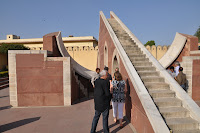Of the five Observatories built by Sawai Jai Sing II, Jantar Matar is said to be the best preserved. Built between 1728 and 1734 its sixteen "Yantras" (instruments) seen from afar resemble a rather giant sculpture composition.
We followed a guide who tried to provide the simplest possible explanations as to what each of these instruments were for, which turned out to be quite an interesting experience taking into account the fact that despite our personal interest or not on these peculiar matters we were witnessing "an expression of the astronomical skills and cosmological concepts of the court of a scholarly Prince at the end of the Mughal period".
Kantivrita Yantra (to be seen in the forefront) - to measure the celestial latitude and longitude of an object in the sky.
Narivalaya Yantra - inclined 27 degrees the sundials represent the two hemispheres and calculate time by following the solar cycle.
Samrat Yantra - this 23 metre high sundial forecasts the crop prospects for the year.
Jai Prakash Yantra - The two sunken hemispheres map out the heavens, though several historians believe that Jai Singh invented this instrument himself to verify the accuracy of all the other Observatory instruments.
Laghu Samrat Yantra - This sundial constructed on Latitude 27° North (Jaipur's Latitude) calculates Jaipur's local time up to an accuracy of 20 seconds.
Rashivalaya Antra - composed of 12 pieces, each of which represents a sign of the Zodiac .
Ram Yantra - Vertical columns supporting an equal number of slabs in the two identical stone structures that comprise the instruments, whose readings aim at determining the celestial arch from horizon to zenith, as well as the altitude of the sun.
Chakra Yantra - A brass tube passing through the centre of these two circular instruments can be used to calculate the angles of stars and planets from the equator.














No comments:
Post a Comment